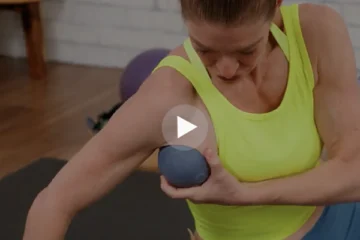
The multifidi are deep to (they live underneath) your erector spinae. Those are your strong cords, the big mamas running parallel to the spine that cause the gullies (laminal grooves) that lie directly next to your vertebra (spine bones). You can get up close and personal with your multifidi by sticking your fingers in those long laminal grooves. You can also poke at the multifidi that cover your sacrum (where your spine and pelvis intersect).
So the multifidi run from your sacrum to the third vertebra of your neck (about two clicks under your skull). They’re essentially lacing the different surfaces of your vertebral arches (the bony projections that sprout off your vertebral discs) to one another. Each multifidus inserts into (ends at) the spinous process living two to four vertebrae higher than its origin (or start). Think of multifidus anatomy like a corset.
Picture, please!

The corset analogy is apt, because maintaining the posture of the spine is an essential function of the multifidi. Our superficial multifidi keep the spine erect, while our deep multifidi are about stability. I learned from a mcr.coreconcepts.com article that the two sets of multifidi are activated BEFORE any action that involves the core. For instance, if you’re about to pick up something, the mulitifidi start to contract before you actually move to prepare the spine for the movement and to keep it safe.
So what are the multifidi like? They’re fleshy and tendinous bundles of skeletal muscle fibers wrapped in connective tissue, known as fascicles. Ann Archer in her About.com article describes the multifidi as short stiff muscle fibers packed inside a long finger-like covering, and cites recent research that shows this particular construction is responsible for the extra strength and support the multifidus gives to the spine. According to Andrew Biel’s Trail Guide To The Body, the fibers of these muscles “form an intricate stitchlike design that links the vertebrae together,” and he contrasts their short, diagonal fibers to the long, vertical fibers of the erector spinae. When the multifidi contract on one side of the spine, they rotate the vertebral column to the opposite side.
(Actually, if you want to know, they resist the spinal flexion (or bend) that would be caused by the contraction of the abdominal muscles that really power the twist. Individually, your multifidi are more about the stability of your spine than the moving of it. That’s from a Medscape.com article I found!)
Finally, when the multifidi on both sides of the spine fire, they extend the spine (Beil, page 206).
Jim Johnson, a physical therapist and author of THE MULTIFIDUS BACK PAIN SOLUTION, notes that “Your multifidi are active and working when you are: standing still, bending forward, twisting to either side, picking or lifting things up, and walking.” They’re also active if you side bend the spine while leaning it forward or back (i.e., if you’re flexing it to either side without being completely upright). And finally, the multifidi are active if the spine backbends against resistance (Johnson, page 8).
That pretty much covers every single thing you’re going to do today. As a deep stabilizer muscles, your multifidi are turned on most of your day.
Learn about our Therapy Ball programs for back pain.
Learn about Yoga Tune Up at home.
Image: http://www.stephanie-spencer.com (Stephanie Spencer)












Love the way you broke down the language to make it understandable for all. Will have to steal the term “big mama’s” to talk about the erector spinae group!
Really enjoyed this article. So many people are hung up on the abdominal muscles, they need to realiz that the muscles on the back of our body, especially the one along the spine need equal billing . Thanks for posting.next time I roll I am going to si hi to my Multifidi
HI Liz, great read, I have never heard of the multifidi muscles until now. I wonder if we are ever really giving these muscles a break? I suppose even when we sleep our spine and the muscles around it are protecting us. I find it interesting that they resist flexion, rather than extension. My forward fold is nothing, where my spine feels nervous and resistance in a backbend.
Thanks for sharing a great description of the Multifidi is one of my favourite muscles.
I did not have a clear picture in my head nor understanding of what the multifidi were until this article. I keep referring to the erector spinae for all spine movements, as if they are the only ones there. I am so happy to have a better picture and understanding of the deep muscle layers of the spine.
Great description of how the multifidi are arranged and the functions they serve in our everyday lives. Since the multifidi are deep to the erector spinae I think we forget that its not just the abdominals that create stability within our movements.
Thank you Liz for a great article about the multifidi. I wish now I could have x-ray yes to see the lovely corset that helps stabilize the spine . Tonight, my multifidi definitely deserves some yoga therapy ball massage for always being active.
Very interesting to learn that the brain sends signals to the mutlifidi to contract BEFORE you start to move – kind of like a pilot yelling “brace yourselves!” before an impact. It also makes sense that given the tasks of keeping the spine supported while doing things like walking and sitting, that it would be turned on most of the time. Is there a way go get the Yoga TuneUp balls in there for a much needed massage!
Fascinating — and to think, I used to only be aware of these during upward facing bow pose…!
Liz, I love being blindsided by amazingly brilliant material. Thanks so much for providing such an extensive list of your resources regarding the Multifidi.
I for one, have never even heard of this muscle called the Multifidi. Now, I’m wanting to learn more. That said, with back pains being so prevalent in our society today, greater understanding of how our back is composed of can only lead to a greater understanding of our back pains.
Brilliant! Thank you.
Wow! I didn’t know of the importance of the multifidi, and how much it truly supports our every action. Excellent writing and much appreciation for referencing quotes, so I can “dig a little deeper”… Thanks again!
Thank you for a well thought out article filled with references! It is always great to get turned on to great nuggets of information but it is also great to have the resources listed for further digging. I am going to check out some of the links you provided and see what other gems I can find to add to my own tool kit!
This is such a excellent article, I have nothing profound to say in response. Thank you for sharing and for all the research you put into this piece.
[…] Tune Up® Blog « The Multifidi – Your Under Underwear, Part 1 Balls to the Wall, and the Blanket, and… […]
I so appreciate this well written blog about the multifidi and also that you sited your sources. I can’t wait to look into these muscles and explore deeper. There are so many layers so much excavating you have articulated this deep layer so well. I can’t wait to take this knowledge to my clients. I’d also like to say that the responses to these blogs have been just a beneficial as the writers. thank you everyone in the Yoga Tune Up community!
I appreciate the analogy you make to the multifidi; that they interlace like the ties of a corset!Cool how they prepare and contract even before you perform the action that will recquire their work!
Namaste, Silvia Marisol
So often we hear about the erector spinae but not the multifidi which is shocking as we are engaging them constantly! I have been enjoying using the Yoga Tune Up balls to “poke” at my multifidi the last couple of weeks! I’ve heard it referred to as the smallest yet most powerful muscle. It’s these series of muscles that allow for so many movements but also the stability of the entire vertebral column! Amazing!
I was attracted to the title of this blog! I love the idea of treating our musclulature like under-underwear to be honed in on an “cleaned,” “ironed,” and cared for like we do our undergarments. Ideally muscles should be cared for first then the actual act of putting on of our underwear would be facilitated.
This is exactly why it feels so darn good to roll YTU balls up and down the sides of the spine. Absolutely everything is connected! Most people just think about the bones in the spine from top to bottom not the multifidis. Great for bringing this forward.
Super interesting Liz. I have been struggling with low back pain for 16 years. I became a dedicated yogini trying to heal my own back- still not there yet but the pain sensations and symptoms have certainly undergone an evolution. One of the most consistent challenges I go through is seizing of the muscles along the left side of my lumbar spine any time I engage those muscles in extension- the most radical manifestation of this occurs during versions of cobra pose. Once the muscles along the lumbar seize up there is a ripple effect right up to the left side of my neck. I’ve gone through thinking the root cause of this trouble is left SI issues and that the erector spinae are the seizing culprits. My eyes are opening to the multifidi and the course they run from sacrum to the cervical vertebrae and the fairly recent research linking them to chronic low back pain.
Hopefully I will find a solution since back bending provides great strengthening for the low back and amazing massage (belly backbends) and relief for the abdominal organs.
As the initial panic and sense of being overwhelmed gradually begins to subside in my Yoga Tune Up teacher training course with Jill I am beginning to understand and appreciate how and why the body functions as it does. As I gradually begin to learn where each muscle is located and its purpose, this article brought additional clarification and appreciatiion. I especially like the analogy of the multifidi being compared to a corset.
I am sitting on my ball-desk chair…and they are fully engaged (thank god)…stabilizing and keeping me up.
Thanks for the education on multifidis.
Wow, it seems like the Multifidi are the quintessential muscle that we want to strengthen and lengthen for yoga practice, especially now that I know that the Multifidi activates even before the core to keep it safe and that they actually extend the spine when firing on both sides simultaniously. these the “deepest” muscles to the spine?
The detail actions of the multifidi shed light on imbalances I have noted in my body as well as in the bodies of clients- thinking of the corset picture will help me to cue the use of the yoga tune-up balls in a way that is clear to my students. The visuals are clear -and bring more understanding.
Hi Liz, wow, this is an amazing resource. I didn’t know the function of Multifidi. Now I can try to propriocept it in my yoga practice.
Thanks for sharing!